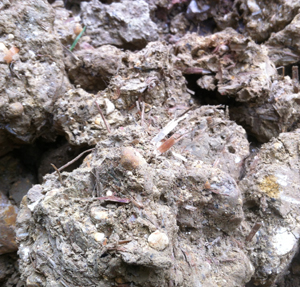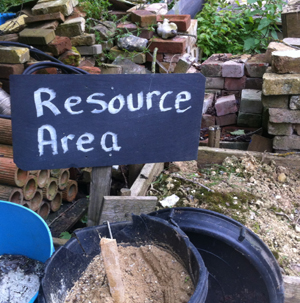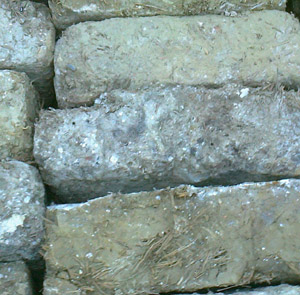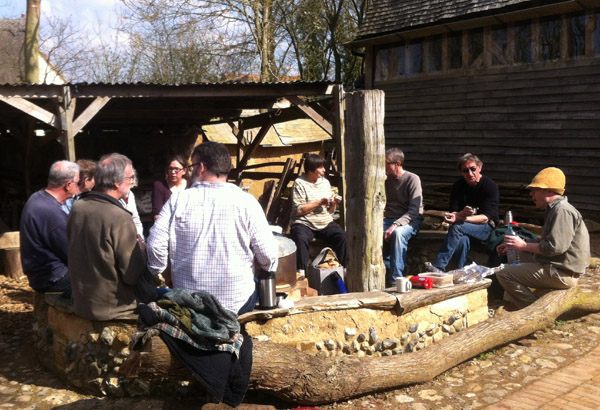
Vintage clay lump block

Buckets of clay rich subsoil for re-use

Reclaimed clay lump blocks (around 200 years old)
|
|
|
|
|
|
|
Building
an Outdoor Seating area from Flint, Cob and Oak 11th June 2018
Necessity, they say, is the mother of
invention. Visitors to Orchard
Barn will know how much we like drinking tea, and fresh air, we
also appreciate the merits of sitting in circle so that everyone is
included! So, in 2011 when the need for outdoor seating arose, I put on
my vernacular thinking cap. I looked around at the resources we had to
hand and possible locations. I considered the range of skills available
and I came up with a plan.
Using reclaimed materials
We needed a sheltered
place that had sun from elevenses onwards, so I decided on an oval
shape to the west of the main barn. We had reclaimed flint bones
scavenged from a nearby wall. There were also oak offcuts from the
outsides of the oak trees we’d had milled for
timbers. They were flat on one side and I decided they would make good
seats, but underneath the ‘seats’ they were still tree shaped, as in
rounded with bark! Hmmmm.
Building with Earth
At the time I’d just finished building a large earth wall from cob and
was still very much in earth building mode. The solution appeared to be
flint foundations with the oak offcuts bedded into the cob (on top of
the flint). Very low tech, but very do-able.
Medieval rawl
plugs
I drew two ovals on the ground, an inner and an outer. Then using
reclaimed bricks and lime mortar I set about
building peers every 4’ or so. I then infilled with flint bones using
an earth mortar. The tricky bit of my
plan was yet to become clear. I removed the bark and sap wood from the
offcuts with an axe. Somehow I had to fix the oak into the cob. Then I
came up with the idea of driving oak pegs and long rusty nails into the
underneath of the oak (not enough to go through, but enough for a good
fixing). Then I slapped cob onto the undulating flint bones to build
the level up about 6”. I bedded the oak into the wet cob and applied
weight (my own whilst drinking tea), and bingo the outdoor seating was
born.
Recycled clay
lump block
The resulting seating area seats 14 people and has been in good service
now for 7 years but due to a wet winter the oak has begun to rock a
bit. Today I decided to undertake those repairs and started to recycle
some reclaimed clay lump blocks containing 200 year old straw. What a
blast from the past to be re-using materials made by previous
generations who presumably knew a thing or two about invention and
using what they had to hand. Such is the nature of the Orchard Barn
project. What goes around comes around! And that includes our building
materials.
If you’d like
to read more about my inventions using vernacular building materials
please subscribe to the Orchard Barn e-news.

Outdoor Seating Area at Orchard Barn
|
|